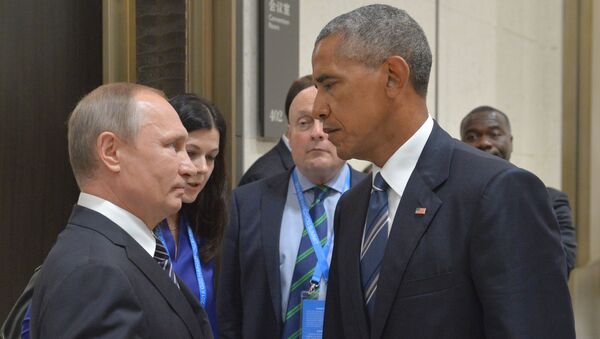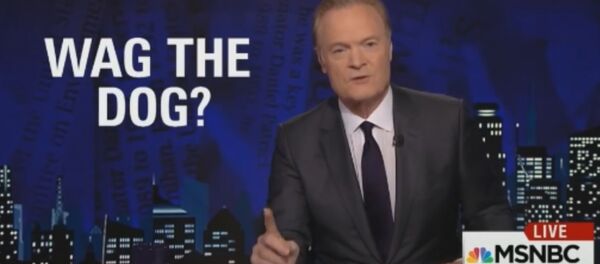MOSCOW (Sputnik) – Diplomatic relations between Russia and the United States were established on November 5, 1809 (October 24, 1809 by the Julian Calendar). However, after the 1917 revolution, the United States refused to recognize the newly established Soviet government, and diplomatic relations between the two nations were only reestablished on November 16, 1933.
In a historically short period, Russian-US relations made a sharp turn from mutual willingness to cooperate to mutual disappointment and gradually increasing aloofness.
On November 7-16, 2001, President Vladimir Putin made his first state visit to the United States in order to hold consultations on the coordination of joint efforts against terrorism, as well as the international situation and developments in Central Asia, Iraq, the Arab-Israeli conflict zone, and the Balkans. Following the talks, Putin and then US President George W. Bush signed joint statements on Afghanistan and the Middle East, cooperation against bioterrorism, combating illegal narcotics trafficking, as well as on new Russian-US ties and economic partnership.
Russian-US relations have soured over more recent years, something which can be attributed to the differences both nations have on the settlement of key international issues. When the internal Ukrainian conflict broke out, the Obama administration decided in March 2014 to curtail relations with Russia. In particular, the United States suspended cooperation of the working groups of the Bilateral Presidential Commission and adopted several rounds of sanctions against Russian individuals and companies. Russia responded by taking countermeasures, both symmetrical and asymmetrical.
In this context, the continued political dialogue at high and top levels became of crucial significance to maintaining bilateral relations.
On September 29, 2015, Putin and then US President Barack Obama held a bilateral meeting on the sidelines of the UN General Assembly in New York. A few months later on November 30, the two leaders crossed paths on the sidelines of the UN Climate Change Conference in Paris and exchanged opinions on Syria and Ukraine.
On January 28, 2017, Putin held phone conversation with incumbent US President Donald Trump for the first time. The Russia leader congratulated his counterpart on taking office and wished him success in his work. During the conversation, both leaders expressed their readiness to make active joint efforts toward stabilizing and further developing Russian-US cooperation on a constructive, equitable and mutually beneficial basis. On April 4, 2017, the two leaders held another phone call.
Meanwhile, on the diplomatic level, Russian Foreign Minister Sergei Lavrov and then US Secretary of State John Kerry maintained regular contacts, meeting over 20 times and holding dozens of phone conversations between 2015 and 2016. John Kerry visited Russia on four occasions: on May 12 and December 15, 2015; March 23-24; and July 14-15, 2016.
On February 16, 2017, Sergei Lavrov held his first ever meeting with incumbent US Secretary of State Rex Tillerson in Bonn, Germany, ahead of the G20 ministerial meeting.
Russia and the United States maintain active contact on current international and regional issues, including the Middle East, Afghanistan, the Korean Peninsula, the fight against international terrorism and other challenges. The two parties have also held talks on Iran’s nuclear issue and efforts to launch the International Syria Support Group to bring about the cessation of hostilities in Syria.
Relations between the Russian and US legislative bodies lost momentum over the past few years due to Congress’s negative attitude toward cooperation with its Russian colleagues in the Federal Assembly. Bilateral contacts further declined following the introduction of sanctions against many Russian lawmakers.
Russian-US trade decreased amid unfavorable economic conditions and anti-Russian sanctions. According to the Federal Customs Service of Russia, bilateral trade amounted to $20.28 billion in 2016, which is down from $20.91 billion in 2015. Russian exports fell from $9.46 billion in 2015 to $9.35 billion in 2016, and US exports dropped from $11.45 billion in 2015 to $10.9 billion in 2016.
In 2016, the United States was placed fifth in Russian trade, 10th in Russian exports and third in Russian imports.
Russia exported the following products to the United States in 2016: mineral products (35.6 percent); metals and metal goods (29.24 percent); chemical goods (17.31
Russia's primary imports from the United States included the following products: machinery, equipment and vehicles (43.38 percent); chemical goods (16.31 percent); foods and agricultural raw materials (4.34 percent); metals and metal goods (4.18 percent); and textiles and footwear (1.09 percent).
Russian-US relations are based on several dozen intergovernmental and interdepartmental agreements, including in transportation and emergency relief. A visa facilitation agreement became effective in September 2012, and Russia as since proposed upgrading said agreement.
Visiting performances by Russian musicians, theaters and ballet troupes in the United States continue to enjoy great success.
Much is being done in the United States to preserve and promote Russian cultural and historical heritage, including running a museum on the site of the Russian colonial outpost in Fort Ross, California.








